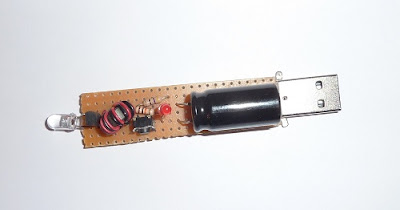Wednesday, September 18, 2013
LED Flashlight Use Supercapacitor
Bored of playing around with capacitors? Then its time for you to move on to super-capacitors. These have huge storage capabilities. In this article you will find out how to build a small LED flashlight using supercapacitors.

The main disadvantage of capacitors is their large voltage drop. For this project, a minimum voltage of 2 volts is required to light the LED. As a result, the “Joule Thief” design would be incorporated here. Using this, a AA battery can be used to light an LED till it is completely discharged.
In this case, a supercapacitor would be taking the place of the battery. Here an LED is used to perform the function of a diode. This ensures that there is sufficient voltage across the LED.

The requirements of the project are listed below:
- White LED
- Super capacitor (10F, 2.7 V)
- Transistor
- Torus
- 1 k ohm resistor
- Wires
- Breadboard
The torus and the transistor used here comes from an energy-saving lamp HS. Care should be taken while removing this from the lamp as a breakage could result in the release of the mercury vapors. A lamp load along with a USB port is added to the circuit. This makes it compatible with a PC or a car radio.

A few precautions have to be taken while constructing the circuit. The USB port should not be provided with excess power. The capacitor does not withstand a high voltage and hence a zener diode is connected in parallel to handle the high voltage. The diode protects the capacitor when the voltage exceeds a certain value.
Related Posts : flashlight,
led,
supercapacitor,
use
Labels:
flashlight,
led,
supercapacitor,
use
Subscribe to:
Post Comments (Atom)
No comments:
Post a Comment
Note: Only a member of this blog may post a comment.